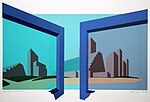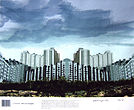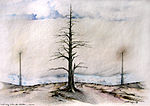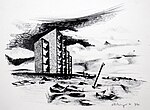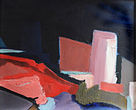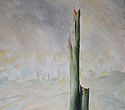Wilfried Körtzinger
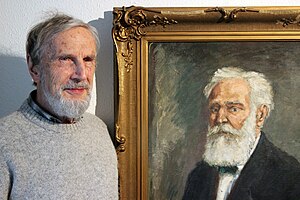
Wilfried Körtzinger (born June 24, 1933 in Brake (Unterweser) ) is a German artist, architect and art educator. He is the nephew of the sculptor, painter, writer and organ player Hugo Körtzinger and father of the marine chemist Arne Körtzinger and the ecotrophologist Inga Asbeck, née. Körtzinger .
Childhood, youth and education
Wilfried Körtzinger spent the first years of his life in Oberhammelwarden on the Lower Weser before he moved to Burglesum / Bremen with his mother in 1939 . He first completed a craft apprenticeship in Bremen. After passing the journeyman's examination and attending evening school, he studied painting with Gustav-Adolf Schreiber and Karl Gustav Weinert from 1954 to 1959, and architecture with Kurt Schulze and Helmut Reischel at the Bremen State Art School . After graduating, he moved to the University of Fine Arts in Hamburg , where he worked in the field of art on teachers such as Berto Lardera (metal sculpture), Max Bense (aesthetics), Otto Lindig (ceramics) and Otto Stelzer (art history) and in the field of architecture on Werner Hebebrand (urban planning) as well as Godber Nissen , Fritz Trautwein and Werner Kallmorgen (architecture).
Professional career
From 1961 Körtzinger worked as a structural architect and urban planner at Bremer Architekten, later as a freelancer at the Bremen Institute for Urban and Spatial Planning. From that time draft arrangements for office and residential buildings, schools and higher garages and mobile buildings come for the Coal and Steel Community . In 1967 he gave up the architectural profession due to a lack of agreement between the required attitude and his ideas of sustainable and humane architecture. He started teaching in Lower Saxony in 1967 and worked as an art teacher and handicraft teacher at the Clemens-August-Gymnasium in Cloppenburg until his retirement in 1996 . From 1973 to 1999 Körtzinger took on teaching positions at universities and technical colleges in Lower Saxony in the fields of art and craft education as well as photography. In addition, he worked continuously as a freelance graphic artist and designed a large number of logos, letterheads, brochures, posters, etc. Körtzinger has lived in Cloppenburg / Lower Saxony since 1967 .
Artistic work
Körtzinger's early works are still strongly influenced by his academic teachers and are close to the Informel . The construction of a printing workshop in his house in Cloppenburg, which began in the late 1960s, initially led to abstract screen prints dedicated to playing with form and color and sometimes taking up elements of Pop Art .
Only then does the artist find his first major artistic theme in dealing with the inhuman and environmentally destructive urban and landscape planning of his time. As a "landscape painter" he is committed to realism , whereby it is not his goal to create images of reality, but symbols of the reality that surrounds him. Körtzinger will pursue the topic of people and the environment for the next three decades, developing his own style that consciously contrasts aesthetic colors and shapes with the serious, sometimes depressing content. Irony is also used in a targeted manner. This is also served by the picture titles, for which Körtzinger repeatedly uses aphorisms by Stanisław Jerzy Lec .
Körtzinger extends the graphic work group to include the printing techniques of etching , lithography and drawing (charcoal, pastel chalk, pencil / colored pencil, ink). In addition, the painting group (oil, watercolor) is added again. He increases the technical quality of his screen prints from initially relatively simple prints with a few colors to complex multi-color prints with well over 20 print runs and iris printing effects and relies on photomechanical screen printing stencils . Initially, these are simple cutting templates, which are later replaced by photo templates, which are alienated through clay separation and painterly processes. For this purpose, the printing workshop is being expanded to include a photo workshop.
The analogue photography develops in Körtzingers second great artistic theme into an independent work group. His "body landscapes" are created in a combination of classic nude and body painting. Large-format painted backgrounds and the corresponding body painting combine to create a new visual reality. In the manual production of the large-format color prints in our own photo laboratory, filter techniques are also used.
Works
The following is a selection of works from the various groups of works and the years 1970–2000.
- gallery
End times landscape , screen print, 1981 (with a quote from SJ Lec : Human ignorance does not lag behind science. It grows just as breathtakingly as this )
acidic landscape , screen print (19 colors), 1983 (with quote from Siegfried von Vegesack : If your soul is sick, then hide yourself like a wounded animal in the woods, they will heal you )
Exhibitions
Since 1967 Körtzinger has been actively exhibiting with over 80 solo exhibitions and a large number of exhibition participations, especially in northern Germany (including Beckum, Bergkamen, Berlin, Brake, Bremen, Brunsbüttel, Bückeburg, Cloppenburg, Coburg, Datteln, Dormagen, Dorsten, Düsseldorf, Gütersloh, Hagen, Hamburg, Hanover, Hannoversch-Münden, Herne, Hildesheim, Holzminden, Iserlohn, Lengerich, Leer, Lemgo, Marburg, Marl, Meppen, Moers, Norden, Nordenham, Oldenburg, Osnabrück, Peine, Pforzheim, Lübeck, Münster, Rheine, Siegen, Soest, Stade, Verden, Warendorf, Wilhelmshaven) and abroad (Denmark, Italy, Luxembourg, Netherlands, Norway, Austria, Poland, Switzerland, Soviet Union, Czech Republic).
literature
- Jürgen Weichardt : Critical landscapes. The graphic artist Wilfried Körtzinger from Cloppenburg . Essay, 1973.
- Ludwig Schreiner: Artists see Lower Saxony , Verlag Weidlich, Frankfurt am Main, 1978.
- Wilfried Körtzinger: Catalog 2, 1985.
- Alexander von Knorre: Short biography of Wilfried Körtzinger and drawing of the landscape of the liberated people of God . The Art Book of Classical Modernism, No. 9, 1986.
- Wilfried Körtzinger: Landscape of the brave new world , catalog 3, 1987.
- Wilfried Körtzinger: Body painting - works of the last years , catalog, 2000/2001.
- Jürgen Weichardt (ed.): Art in the Oldenburger Land , Oldenburg landscape, CULTURCON medien, Berlin / Wildeshausen, 2012.
Individual evidence
| personal data | |
|---|---|
| SURNAME | Körtzinger, Wilfried |
| BRIEF DESCRIPTION | German artist, architect and art educator |
| DATE OF BIRTH | June 24, 1933 |
| PLACE OF BIRTH | Brake (Lower Weser) |




